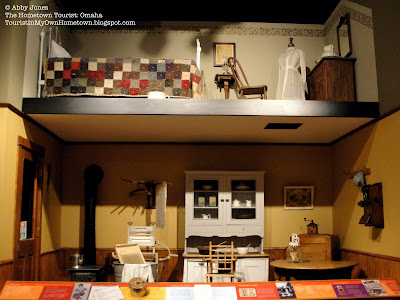When I was in high school, we put together an original show called Union Station to Tokyo Bay as part of the Victory 95 celebration commemorating the end of WWII. We performed it at the old Firehouse Dinner Theater in the Old Market. (The Firehouse closed a couple of months later - no fault of ours, I'm sure!) For that weekend in September, my friends and I basically lived downtown. We arrived early to get ready for the matinee, then walked the cobblestone streets and explored the shops until it was time to go back for the evening performance. I'd been to the slides at the Gene Leahy Mall with my family before, but this was my first time really exploring the Market, and I loved it.
I had no idea that Union Station was just a few blocks away. Looking back, I'm not sure whether the "Union Station" in the show's title was a reference to the one in Washington D.C. or the one right here in Omaha. Our teachers picked it, and I never thought to ask. Maybe it was both.
Built by Union Pacific, the building at 10th and Leavenworth opened in 1931. It was designed as an art deco show piece, fitting for a station that was so close to the company's headquarters.
When rail travel was at its peak, this was one of the busiest terminals in the country. On an average day, 10,000 passengers came through this particular Union Station. Intricately detailed bronze sculptures give us a glimpse back into that time.
The best history lessons are the ones you can climb right into - literally. Like this train car.
Or this streetcar. You can even take a turn at the controls.
Omaha started out as a "Walking City." But when streetcars began to run, the "Streetcar Suburbs" developed - like Fontenelle and Benson. The cars ran in a big loop, connecting each part of the city, with gardens and parks built in between. When you sit in this streetcar, you can look out the windows and see a little bit of what those passengers might have seen.
It's too bad you can't climb into these cars. Still, they're fun to look at. Which one do you like the best? Personally, I'm a big fan of the old convertible.
Or maybe you prefer really old convertibles? If you can tear yourself away from the trains and cars, there's a pretty neat display that helps show how people first arrived in Omaha.
No McDonald's along the way? No problem.
Pop quiz - how do you keep your eggs from breaking on a long, bumpy journey?
Houses like this came long after the time of covered wagons, but before those modern marvels of air conditioning and indoor plumbing. Well, it kind of had air conditioning - if there was a nice breeze. I wonder if that's why so many people had rocking chairs - to stir up a little extra air?
They found ways to entertain themselves without television.
And they made good use of every inch of space.
Omaha is well-known for its medical centers today, and that tradition goes back to its early history. Clarkson Hospital was founded in the early 1900's. But privacy laws regarding health information are relatively new.
Here's a closer shot of the same page. I wonder what "Acute Plumbism" was? Sounds painful...
An early wheelchair, which could also double as patio furniture. (Just kidding.)
This last photo really has nothing to do with the rest of the blog, but it was too good to leave out. Cudahy's was one of the big meat packing plants in town. And here was one of their specialty items...
If you haven't lost your appetite, be sure to stop at the old-fashioned Soda Fountain or Candy Shop!
There are also interactive activities for the kids, a photo archive, and a temporary exhibit on natural disasters running through September 12th.
Admission to the Durham Museum is $7 for adults and $5 for kids ages 3-12. (Kids under 2 are free.) Free parking is available in the museum's two-tiered lot.


























What a fabulous article Abby! We will post this on our Omaha Old Market fb page!
ReplyDelete